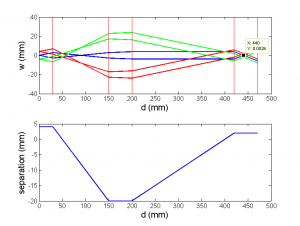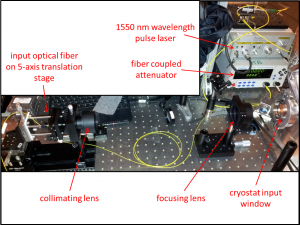Free space Coupled Superconducting Nanowire Single photon Detectors
- Category: Optics & Photonics
- Tags: francesco bellei, karl berggren
Superconducting nanowire single‑photon detectors (SNSPDs)[1] are a technology that combines single‑photon sensitivity, high speed, and high time resolution in the visible and near‑infrared wavelength range[2]. These features make SNSPDs suitable for optical communication and other applications[3]. For SNSPDs to be used in quantum communication, quantum key distribution or failure analysis in VLSI circuits[4] high system detection efficiency (SDE) is also required. Recently high SDE has been demonstrated for SNSPDs based on WSi (SDE > 90%)[5] and NbN (> 76%)[6] by employing passive or active fiber‑to‑detector alignment.
The availability of standard optical fiber mounts on the market makes it easy to integrate an optical fiber even at cryogenic temperatures. However, the 1‑to‑1 correspondence between the number of fibers and the number of SNSPDs makes it difficult to integrate several channels in the same cryogenic system. In addition, mid-infrared experiments are limited by the large diameter of mid‑IR optical fibers’ cores. We propose a 4‑lens system to couple 1550-nm photons in free‑space from an optical fiber at room temperature to an SNSPD chip mounted inside a vibration‑isolated cryostat at T = 3.2 K. The system is designed to focus the beam into a 5‑µm‑diameter spot (Figure 1) that can be swept over a 4×4 mm2 area, preserving its dimensions. The advantage of a free‑space coupling system is that the only optical element integrated in the cryostat is the lens that ultimately focuses the light on the chip.
We have already built a preliminary version of the free‑space coupling setup with only 2 lenses (Figure 2) able to focus the beam to an 87‑µm‑diameter spot. Both lenses were mounted at room temperature outside the cryostat. We tested a large‑area circular‑shaped SNSPD (63.6 µm2) with maximum device detection efficiency DDEmax = 12%. For this detector we obtained a DCR = 14 k counts/sec at bias current equal to 97.8% of the SNSPD maximum operating current and a maximum SDE = 0.2%.
- Figure 1: a) Beam waist (w) propagation of three beams initially separated by 4 mm propagating in a 4-lens optical system. The first four vertical red lines represent the position of the 4 lenses. The last red line is a fictitious end plane. b) Separation between the center of a beam initially shifted 4 mm from the optical axis and the optical axis itself as a function of position (d) on the optical axis.
- Figure 2: Picture of the two-lens free space coupling optical system used to obtain a maximum system detection of 0.2%. The source was a fiber coupled fs pulsed laser. We used a fiber coupled attenuator to regulate the laser power. The window aperture in the cryostat is 1.25” in diameter.
- G. N. Gol’tsman, O. Okunev, G. Chulkova, A. Lipatov, A. Semenov, K. Smirnov, B. Voronov, A. Dzardanov, C. Williams, and R. Sobolewski, “Picosecond superconducting single-photon optical detector,” Applied Physics Letters, vol. 79, no. 6, p. 705, 2001. [↩]
- F. Marsili, F. Najafi, E. Dauler, F. Bellei, X. Hu, M. Csete, R. J. Molnar, and K. K. Berggren, “Single-photon detectors based on ultranarrow superconducting nanowires,” Nano letters, vol. 11, no. 5, pp. 2048–53, May 2011. [↩]
- E. Dauler, M. Stevens, B. Baek, R. Molnar, S. Hamilton, R. Mirin, S. Nam, and K. Berggren, “Measuring intensity correlations with a two-element superconducting nanowire single-photon detector,” Physical Review A, vol. 78, no. 5, pp. 1–4, Nov. 2008. [↩]
- F. Stellari, A. Tosi, and P. Song, “Switching time extraction of CMOS gates using Times-resolved emission (TRE) ” pp. 566–573, 2006. [↩]
- F. Marsili, V. B. Verma, J. A. Stern, S. Harrington, A. E. Lita, T. Gerrits, I. Vayshenker, B. Baek, M. D. Shaw, R. P. Mirin, and S. W. Nam, “Detecting single infrared photons with 93% system efficiency,” Nature Photonics, vol. 7, no. 3, pp. 210–214, Feb. 2013. [↩]
- D. Rosenberg, A. J. Kerman, R. J. Molnar, and E. A. Dauler, “High-speed and high-efficiency superconducting nanowire single photon detector array,” vol. 21, no. 2, pp. 1440–1447, 2013. [↩]

